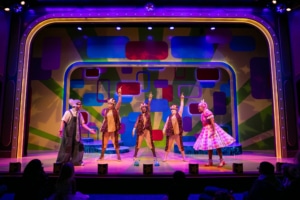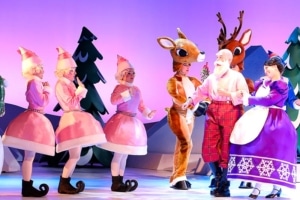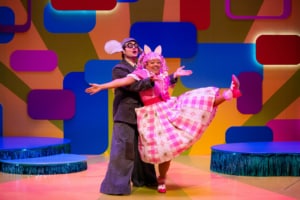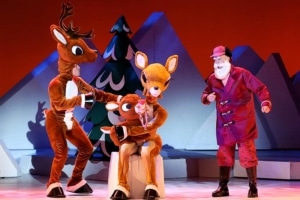DCPA NEWS CENTER
Enjoy the best stories and perspectives from the theatre world today.
Enjoy the best stories and perspectives from the theatre world today.
The feeling of seeing a story unfold live on stage is unlike anything else, and it’s absolutely something to share with your children. When they’re ready, that is.

The cast of Elephant & Piggie’s “We Are in a Play!” Photo by Jamie Kraus Photography
While there’s no set age for when kids can be introduced to the stage — each child is different after all — there are signs to look for that indicate that they may be ready. Can they sit mostly still through a feature-length movie at home? Can they watch something without talking through the whole thing? Do they want to go to the theatre? Ask these questions first, and then decide where to go to from there.
When They Are Ready To Go
Once the answer to all these questions is yes, then it’s time to pick your show. Start with something kid friendly, and short if possible. Right now DCPA Education is presenting Elephant & Piggie’s “We Are In a Play!”, a musical adaptation of Mo Willem’s best-selling children’s stories. The production is geared toward those in PreK up to third grade, with morning and afternoon shows only.
Rudolph the Red-Nosed Reindeer: The Musical is also coming to the theatre soon. Most kids know the story, so seeing it live can add to the excitement. This show only plays November 29 through December 1 at the Buell Theatre.
Lastly, a family favorite annual production is the Denver Center Theatre Company’s A Christmas Carol. This production is a tad longer with an intermission, so you might consider bringing your older children.
Good Manners

The company of Rudolph the Red-Nosed Reindeer: The Musical
Before heading to the theatre, go over the basic rules of how to behave, which may be different depending on the show you are about to see. Don’t block the people behind you, so stay seated unless you’re encouraged to move. Don’t interrupt the story by singing along or talking out loud, unless the cast asks you to. And save your questions for intermission or after the show. For kids who tend to be wiggly, advise them to sit on their hands unless your show is interactive, and you’re invited to touch.
That said, it’s okay if kids talk a little especially if the show is geared toward children. In that case, it’s expected there will be a bit more noise from the audience than normal.
Make It Special
While the theatre alone proves exceptional, it doesn’t hurt to play that up by letting your kid feel special too. Have them pick out their outfit or buy something pretty and new to wear. Some might like wearing a piece of your jewelry, a scarf, fun shoes, or any accessory they usually don’t have access too. A meal before or after the show is another way to celebrate, and a good time to talk about what to expect or what they experienced.

Sean Scrutchins and Michaela Murray. Photo by Jamie Kraus Photography
Tips For Bringing Kids to the Theatre
When ordering tickets, see if the theatre offers an age recommendation. If you’re on the fence, call and talk with a ticket agent who can provide you with additional details to help you make a decision that’s right for your child.
Height matters. Before going to the theatre, make sure your child is either tall enough to see the stage from their seat or check with the theatre to see if they provide booster seats. Many do, and those extra inches allow little ones to take it all in without standing up.
Let little kids bring a beloved stuffy or small doll, just as long as it doesn’t make any noise. The lovey can help a restless child calm down or give them something to fidget with. Some kids just enjoy letting their make-believe friends experience a new thing together.

The company of Rudolph the Red-Nosed Reindeer: The Musical
Feed the beasts! No one wants to be around hungry kids. Make sure they are fed before the show. Many theatres offer concessions before the show or during an intermission, but due to shorter run times for many child friendly shows, there may not be an intermission – so plan accordingly.
Make sure to visit the bathroom before the show. Even if they say they don’t need to go, explain that once the curtain is up, they can’t leave and come back.
If you’re nervous, don’t forget about bribes! Even a small piece of candy can be good incentive to keep kids focused and quiet during the show. It doesn’t have to be huge. A simple, “If you can be quiet for the whole first half, you can have a lollipop after” often works.
After the Show
Be ready to talk with your kids on the way home. They will be bursting with enthusiasm and curiosity. Many productions provide study guides, family resources and children’s activities that further enrich the experience. Look online or ask when arriving. These are the finishing touches that will take their experience from great to memorable!
Once the performance is done, talk to your kids about what they saw, what they liked, and what they wish was different. Praise them for good behavior and make a point to show your gratitude that they came to the theatre and shared the experience with you. Then, make plans for your next foray.
Check out these resources for upcoming DCPA productions!
Denver Metro Family Friendly Restaurants
Elephant & Piggie’s “We Are In a Play!”
Create Your Own Elephant & Piggie Story
Play Make Believe with Elephant & Piggie
Rudolph the Red-Nosed Reindeer: The Musical
